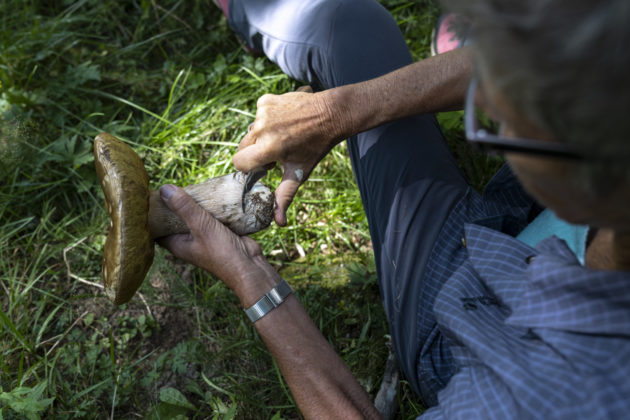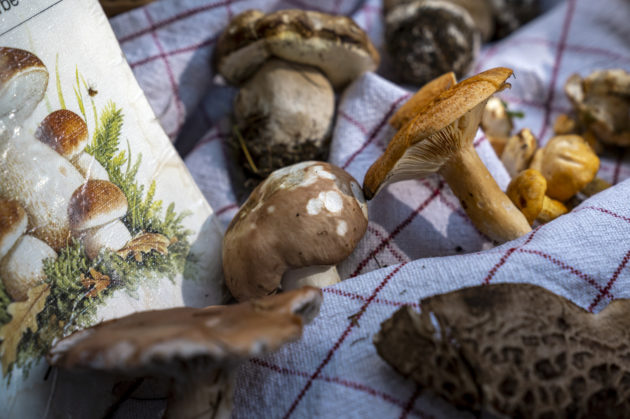Menu
Search
An excursion with a mushroom expert reveals some of the delicacies that flourish in the Engadin forests – including the Cep, known locally as the Steinpilz or “stone mushroom”
It is one of those glorious late-summer mornings in the Engadin. The boundless sky is a piercing blue, the mountain summits seem close enough to touch, and the air feels as fresh as if it had just been washed. Rosemarie Kuhn lays a tea towel on the ground and straightens it out. On top of it she puts mushrooms of all sizes: two Chanterelles, a Russula, a Scaly Hedgehog and a small Cep (or Porcini).
Several people wearing hiking gear and carrying baskets stand around Rosemarie, watching carefully. Rosemarie is an official mushroom inspector. Or at least that was the name of her position until recently; she now calls herself a mushroom adviser. Today, the native of St. Gallen is leading a mushroom excursion, as she has done for more than 24 years. It all began with a giant Cep, she recalls. It was as big as a child’s head. The 6-year-old Rosemarie saw it at an exhibition, and it had a lasting effect on her. At the age of 20, she moved to Lenzerheide and worked in a sports shop; later she married a ski instructor, had two children, and worked in adult education until she retired. Somewhere along the way, her passion for mushrooms resurfaced. But not because she is a big fan of mushrooms in food. “Actually I don’t really like eating mushrooms,” she laughs. “It’s the botany, the variety of this wonder of nature, that fascinates me.” She completed a mushroom course at the Migros Club School in Chur, joined the local mushroom association and took the test to become an official mushroom inspector. But she didn’t want to be limited to the classic role that the position entails. “Just checking baskets full of mushrooms, that wasn’t my thing,” she says. Rosemarie always saw herself more as a communicator than a monitor. “Passing on knowledge, advising, educating – that’s closer to my heart.” So she started with the excursions: first in the Lenzerheide region, and now throughout Graubünden.

During the walks through the forest, she explains to participants the difference between gills and pores, how to pick a mushroom correctly, and demonstrates the stages in a precise identification.
“At first I often had only one or two people coming along,” she says. “Today, up to 15 people take part in an outing – recently with more and more young people and whole families.” That delights Rosemarie – although it means that in August and September, high season for mushrooms, she hardly has any free time. Off-season, she also offers guided walks focusing on wild herbs together with her colleague, Vreni Conradin. “There are about 6,000 kinds of higher fungi,” Rosemarie tells the enthralled visitors. “But if you’re a beginner, you need only a small mushroom identification book with maybe 100 species.” She then explains that you always require the whole mushroom to identify it, and reveals why a plastic bag is unsuitable for mushroom hunting. The mushrooms cannot breathe inside and quickly perish – in fact Ceps even turn poisonous. She also recommends obtaining a dedicated mushroom knife with integrated brush; that way, you can clean the mushrooms right away in the forest. The group now sets off through the forest above Champfèr. Do mushroom hunters reveal their top spots? Vreni, who has joined today’s excursion, laughs. Of course she and Rosemarie have their favourite locations, where they go and look first – but these places are not secret. “The forest is big and there’s enough for everyone,” Vreni says.
Mushrooms are good for desserts, too: another of the outing’s surprising discoveries.
The party stops in the middle of the forest to learn how to tell the difference between pines, spruces and larches. As 40 per cent of fungi live in symbiosis with a tree, an ability to identify specimens boosts chances of a lucky find. Some fungi prefer Swiss stone pines, others favour spruces – as do the Ceps.
Rosemarie sends the participants out for a first time, just to have a good look and then bring back whatever kinds of mushrooms they can find. “But please only pick one or two at each location,” she says, “don’t take the whole lot.”
The participants fan out, pick their way through the undergrowth, and soon are no more to be seen. Now and again, the snap of a twig or some hushed conversation drifts through the air; otherwise, the only sound is the wind rustling through the larch needles. Half an hour later, the mushroom hunters are back, spreading out their finds on tea towels. There is something reverential, almost sacred, about the way Rosemarie takes each mushroom in her hand, examines and classifies it. “That’s a Butter Cap. And here we have a Peppery Bolete. You can dry it and use it like pepper.”

Among the mushrooms on the tea towels are Fly Agarics. Rosemarie explains exactly how to identify one, even when it doesn’t have any of the distinctive white spots.
Rosemarie says that Fly Agarics favour the same spots as Ceps – and adds that in ideal weather conditions, a Cep can grow up to 10 centimetres in a single night. The Wood Blewit that one participant has brought along is suitable for pickling, she reveals. With every detail and new piece of information, we fall deeper under the spell of the mushroom world and easily understand Rosemarie’s passion. The next time everyone sets off, gazes have sharpened noticeably and the technique of lifting and twisting out each mushroom with a knife has become more expert. Everywhere on the ground, little white and brown hats are to be seen, peeping out. The more you get into the subject, Rosemarie says, the greater your chances of striking lucky. After five fascinating hours in the forest, it’s time to head over to the Restaurant PappaLoù in Silvaplana. Here, the mushroom hunters pool the edible booty and bring it to the kitchen. Soon afterwards, the Cloud Funnels return as an appetizer steamed in butter. Next come mixed mushrooms in a salad, and then fried Ceps with fresh parsley on tagliatelle. And to round off the meal, a surprise: a caramelised Boletus. The fact that mushrooms are even good for making desserts is the latest happy discovery from this captivating excursion: together with roasted nuts or in a Kaiserschmarrn pancake, a real delicacy.
Book a mushroom excursion with Rosemarie

